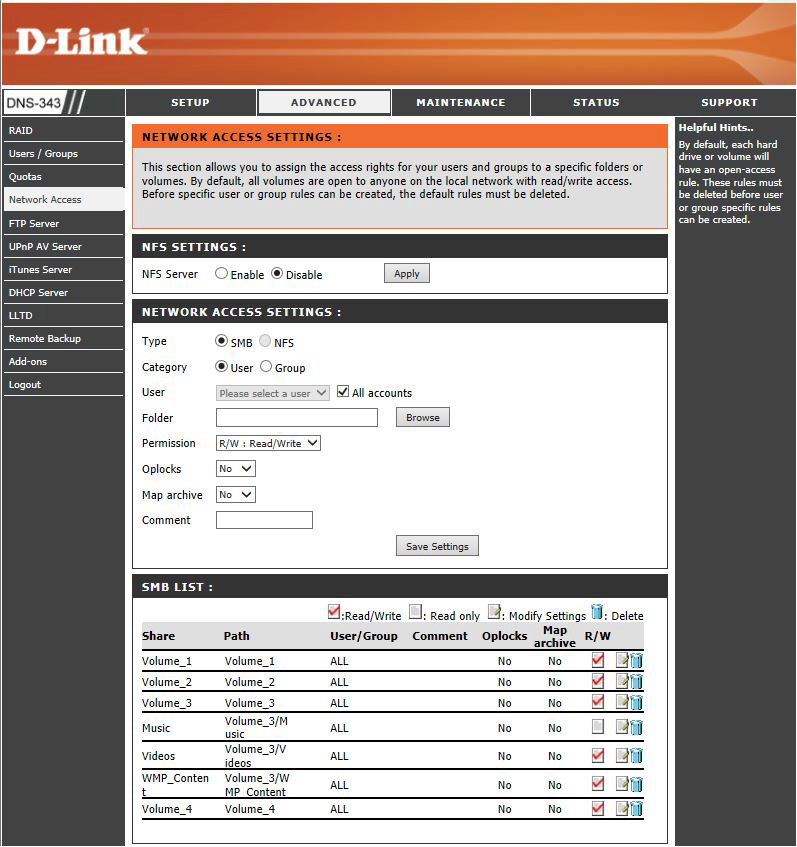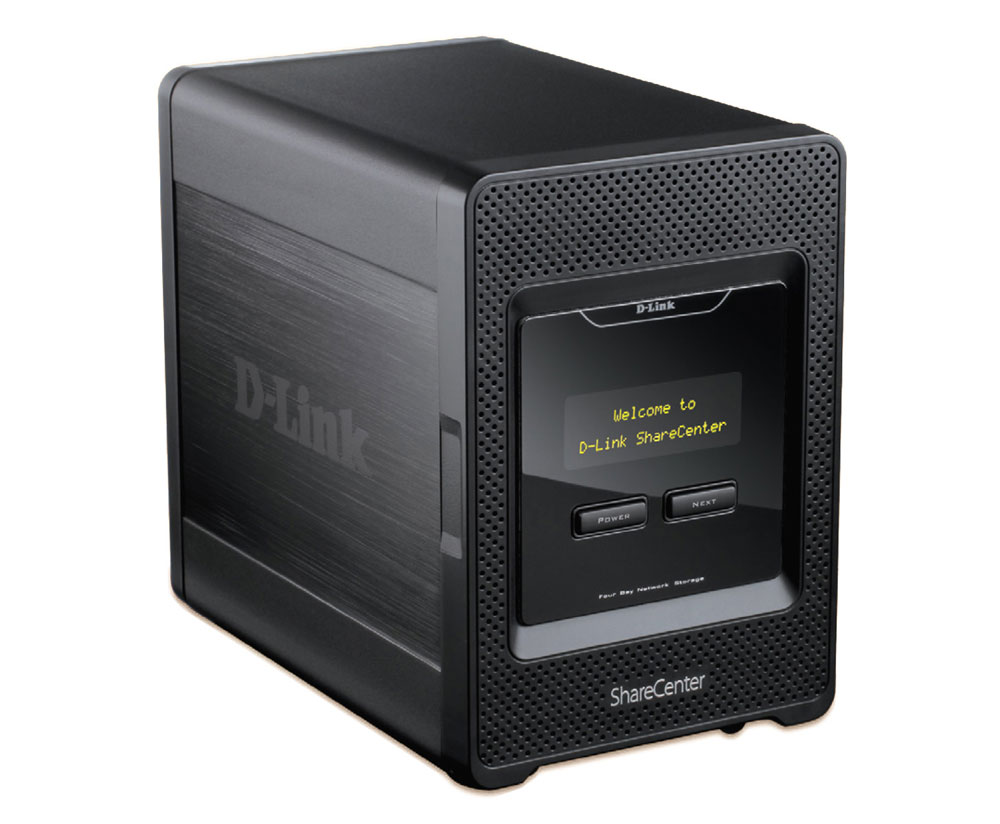How to set folders and permissions.pdf (189.07 KB) Download. How to restore raid one if one of the hard drive fails.pdf (14.35 KB) Download. DNS-323-343 USB Compatibility List.pdf (134.38 KB) Download. DNS-323 HDD Compatibility List.pdf (90.13 KB) Download. D-Link Makes your Smart Home Smarter, Safer and Truly seamless. Get started with our award-winning Smart Home technology, Whole-Home Wi-Fi, IP cameras, and more today. The DNS-323 can automatically back up your data regardless of your computer’s operating system (Windows ®, Mac ®, or Linux ®). For Windows users, the included feature-rich backup software can help you create schedules and rules including real-time full or incremental backups and storage quotas for specific users and groups. D-Link Systems, Inc. Recommends retiring these products and replacing them with products that receive firmware updates. D-Link DNS-323 is a Compaq N1000c laptop running on the CD-ROM. Vincent Danen tells you how the D-Link DNS-323 NAS box can be hacked with a set of scripts to become a full-fledged Linux server. To and release the release, but also have network shares. The simplest way to access your DNS-323 is to use theEasy Search Utility provided on the CD-ROM.
- D-link Dns 323 Drivers For Mac Os
- D-link Dns 323 Drivers For Mac Computer
- D-link Dns-323 Easy Search Utility For Mac
Time goes on and so do update all the systems we use – as much as any does Windows 10 and not so much – D-Link DNS-323 network storage disk system. This has caused, after a major Windows 10 update, the network share previously available on the D-Link nas, to become not available to access from the Windows 10 machine. More specifically, the big red error message above is popped.
Mod central. “You can’t connect to the file share because it’s not secure. This share requires the obsolete SMB1 protocol which is unsafe…” etc etc. A long message, ultimately asking you to update the share to use SMB2.
Well let’s turn on SMB2
Well, I tried, but there is no option to enable SMB2 on the DNS-323.
So what’s the story?
A bit of searching and turns out Microsoft has already back in 2016 urged everyone to stop using SMB1 and finally shut it off from use now. Microsoft has also listed all known products that use SMB1 and D-Link DNS series NAS-s are listed.
In the D-Link support section the situation is explained as follows: The latest update from Windows 10 disabled SMB v1.0. The D-Link DNS line of NAS devices uses SMB v1.0 and does not support SMB 2.x. You must enable SMB 1.0 in Windows 10 to map a drive and view drive content. So no software update from D-Link, just reverting back to SMB1. And they also suggest you turn on all SMB1 services on your PC to solve it.
But wait…

Why would I need to enable SMB1 server on a Windows 10 machine if you only need to connect, not serve files? You are right, you don’t, so don’t follow those instructions.

Here is how you gain back access to your D-Link DNS-323 network bay from Windows 10:
- Type “Turn windows features on or off” to your Windows 10 search box and open it
- Scroll down till you find SMB 1.0/CIFS File Sharing Support. Click on the plus sign to expand it and mark only SMB 1.0/CIFS Client. Click OK.
Now you should be able to connect and access your D-Link DNS-323 NAS without any issues. But bear in mind, it is not safe to use SMB1 – two global ransomware outbreaks, WannaCry and Petya, spread quickly because of a vulnerability in Server Message Block version 1.
The DNS-323 does not support external discs, but a small hack allows you to use them on the unit anyway. Before you even try this, you need to have telnet access to your device.
Note: If you're a linux newbie and the steps below are too difficult for you, there is more background information and a set of “steps for dummies” to connect external USB drives to the DNS-323 at Attaching USB Storage to the DNS-323 for Linux Newbies & Dummies.
WARNING
I just want to issue a small warning here as we currently don't know what happens when the unit is powered down. There is a risk that connected USB discs are not unmounted properly at shutdown or reboot.
Load USB Storage Module
The first thing you need to do is to add an extra module to your system. Paul has been so kind that he has produced such a module for you to download for v1.03 (working for 1.04 too).
Here you can find a discussion about usb-storage module compiled without debugging enable. Download optimizing module here (firmware >=1.03).
Store that file somewhere on your disc, e.g. in the ./lnx_bin/. directory of your unit. Next step is to telnet to the device and load the module to the kernel:
Then plug your USB disc into the USB slot and watch your system log, i.e. issue command dmesg. It'll look something like this:
Please note the 'sdc' above as it might differ when you insert your disc. Use your device.
Explicit Export
Next step is to create a mount point for the disc and to mount it:
Please note the -t vfat here as it is a FAT volume in this example.
Example of mount for external drive with one ext2 partition:

If you need UTF8 support for a FAT32 file system in order to handle an extended character set (greek, chinese, german umlauts, …), add the -o utf8 option to your mount command:
If you also want to share this disc to your other computers you'll have to make it visible through samba. Edit the /etc/samba/smb.conf file and add the following:
After this, restart the samba deamon using the command:
.
Implicit Export
If you don't want to go all the trouble editing samba files and restarting samba server you can instead create the mount point on an already exported disc:

If you don't want the whole drive in one share, you can add symbolic links to existing shares, that will take on their users and permissions. Mount the disc to a point that exists, but outside the shares, then add a link inside the share. In this example, there is a folder on the USB drive called “Public” and an already shared folder on the first hard drive called “Public/Share”. There will be a new “folder” (the link) created and it will be visible at “Public/Share/USB_Drive”.
You might need to chmod 777 or 755 your usb drive. You only need to make the links once. Then you can mount and umount your drive after that without changing anything.
D-link Dns 323 Drivers For Mac Os
Unmount
If you want to safely unplug your USB harddrive, you can use the umount command (not unmount). It's probably a good idea to do this if you are turning off or restarting your DNS-323.
Example:
Fun_plugging
And; you can of course do all this in your fun_plug. The following is the contents of of a fun_plug which resides on a machine which has two external USB discs and a printer connected through a USB hub:
Proposed Functionality
An obvious (and very useful) extension to the work you guys have put into USB functionality would be a plugin which automatically copies the entire contents of a USB stick to a directory on the drive. It would be pretty simple to code, I imagine
Another useful extension would be automatic backup to a usb disk which afterwards can be carried off site.
Is it technically possible to use the USB to connect DNS-323 to PC, as an external USB hard drive? The reason to do this would be to get better throughput when playing HD movies in Windows. I understand DNS-323 is using EXT2 which is supported by Windows using ext2fsd (http://ext2fsd.sourceforge.net) or ext2ifs (http://www.fs-driver.org).
⇒ I think that would require the USB port to be working in host mode which I don't believe is electrically possible in this case.
Partitioning and formating of external hard disk drives
The external drives need to be partitioned and the partition which should be mounted needs to be formated with one of the possible file systems, i.e. EXT2, FAT16, FAT32 or NTFS. If your drive isn't already partitioned or formated as needed there are the following possibilities to achieve this need:
1. Connect the drive to a linux pc and partition and format it there, using i.e tools like GParted.
2. Partitioning and formating can even be done with the DNS323 itself in a telnet session using the command line tool fdisk. Please be very careful with this tool, because if used wrongly you could lose all your data. You need an up to date version of the fdisk tool; otherwise, you may get a segmentation fault. You can get a working version from this post in the forum: ”ffp's fdisk dies with segfault”
Take a look at your internal disks /dev/sda or /dev/sdb as a reference and exit with “q”. You may want to create a linux partition (partition type 83) similar to the internal drives. If you want to format a partition with EXT2 filesystem, use
After partitioning and formating you can check you partition with e2fsck /dev/sdXn
D-link Dns 323 Drivers For Mac Computer
Finally, try to mount the newly created partition.